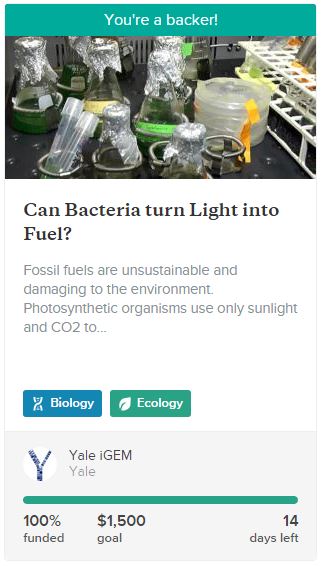
This morning, I helped scientists analyze fish scales to better track migration patterns. I also made it possible to engineer bacteria that could produce biofuels and to study avalanche history in Colorado to understand effects of climate change. And I did it all without leaving my house. I contributed money to each of these projects, using a crowdfunding site called Experiment.
Crowdfunding has made a difference in all sorts of initiatives, so it’s no surprise to see it pop up in science. Experiment was built by scientists who believe that alternative funding models could fill a key gap in the research landscape. Scientists whose research is underwritten by government or philanthropic grants routinely face a Catch-22: to win a grant, they must submit enough preliminary data to demonstrate that their concept is likely to succeed. But to get that preliminary data, they need funding.
It’s a problem Cindy Wu experienced firsthand during her biology training. After conducting a successful research project to create a drug targeting anthrax, she suggested a small follow-up project that would apply the same concept to other bacterial pathogens. She pitched the idea and its relatively small budget of $5,000 to her lab director at the University of Washington. He told her the idea didn’t fit the sweet spot of grant funding agencies—it was too small-scale and too risky, and came from someone who hadn’t yet earned her PhD. The lab director did what most scientists do: peeled off a small amount of money from a large grant for another project that had a little wiggle room in the budget.
But Wu had seen enough. She deferred a PhD program and teamed up with fellow student Denny Luan to launch Experiment to see whether crowdfunding could be a successful alternative means of raising money. If scientists could get funding for small-scale experiments like the one Wu had pitched, they could generate preliminary data, putting them in a better position to apply for a large-scale government grant later. But would people kick in enough money to make the idea work?
They started small in April 2012, choosing nine out of 100 applicants for their first funding projects. Wu and Luan taught themselves to code and built the site, originally called Microryza, which included videos and clear descriptions of the science projects. Since then some 17,000 users have pledged more than $4 million, funding more than 350 projects. Projects tend to be fairly small, with funding goals averaging about $10,000 to support very specific, well-defined tasks. Once funded, researchers provide updates to their supporters as the work progresses.
According to Wu, most projects come from scientists in academia, though her vision is that crowdfunding could also facilitate DIY studies for non-PhD-holders. “Our end goal is to create a world where anybody can be a scientist,” she says.
In the past three years, Experiment has gone from a hunch about crowdfunding to what seems a viable company. In their first year, Wu and her colleagues moved to San Francisco when they were accepted to the prestigious Y Combinator accelerator program. Now they have raised about $2.5 million from angel and VC investors interested in new ways to make science more efficient.
How Crowdsourcing Can Help Fund Science
This morning, I helped analyze fish scales to better track migration patterns, by giving the scientists some cash. Crowdfunding has made a difference in all sorts of initiatives, so it’s no surprise to see it pop up in science. Experiment was built by scientists who believe alternative funding could fill a key gap in research.
















